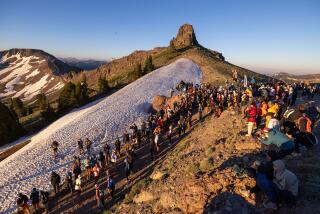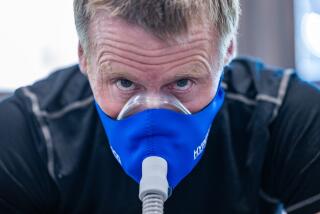The Last Adventurer : Competition: When French journalist Gerard Fusil ran out of challenges, he created his own--the Raid Gauloises, the ultimate in exotic endurance tests.
Gerard Fusil, broadcaster and race master, is built for speed. Not tall but graced with a bullwhip physique and a powerful imagination, he has propelled himself from France to the South Seas at the velocity of sound waves--first creating a new view of sports for his radio audience in Europe, then creating new sports.
He is not content, like most electronic sports journalists, to sit in a control room, watching the action on the field. Fusil, 44, prefers the field itself: The desert, the ocean, the mountains, the jungle.
For millions of listeners across the Continent over the last 15 years, it has been his voice--panting or jubilant right alongside competitors--that has brought news at 7:30 a.m. of the Tour de France bicycle race, Paris-Dakar desert road rally or America’s Cup yacht race on the radio network Europe 1.
The Frenchman has even been a competitor himself, joining a four-man crew in 1981 to break the transatlantic yacht record in a journey of 9 days, 10 hours, 6 minutes and 34 seconds.
Today, though, his agenda is clear. There will be no races to cover for the next few months. Fusil has designed his own competition. And this time, he hopes, the world will be watching him.
His invention is the Raid Gauloises: a 10-day unmechanized race among five-person teams in an exotic locale. No engine-, cycle-, or sail-propulsion allowed; just feet, canoes, horses and a push from a plane. It’s the rules of the jungle; a race for survival. The first team to finish intact wins 200,000 francs, or $37,000.
Last December, Fusil held the first Raid in the rain forests and high mountains of New Zealand; only nine of 26 teams finished with all five members, the rest falling victim to sprained ankles and mental breakdown. This December, the route shifts to the jungles and volcanoes of Costa Rica. More than 55 teams have signed up at $6,000 each so far, though Fusil expects the number to drop to 40 by the time the starting gun is fired.
The ranks thin for reasons that become obvious as potential competitors worldwide prepare over the summer and fall. The enormity of the task they have taken on looms larger and larger. Consider:
* The course, if you can call it that, stretches more than 230 miles from the Pacific Ocean to the Caribbean. Fusil vows that it will cross no major roads, but will not reveal any details until a week before the event. Every team must have an expert orienteer because there is no real path, only checkpoints to reach. Fusil will hand each team 20 interlocking maps and a emergency rescue beacon at the start of the race. Then, he’ll wish them luck. It is strictly BYOC: Bring your own compass.
* The race is run in seven stages. Each demands a different skill. Probably the most demanding is called “run and ride,” in which the team of five is given three horses. Two other stages include rafting or canoeing down rivers with extremely difficult rapids. Another three stages have competitors bushwhacking at top speed through steamy jungle heat to the summit of 12,500-foot volcanoes. And in the last stage--”just for fun,” says Fusil--racers will parachute from an airplane.
* Competitors must carry their own food and camping gear, though they may be resupplied at checkpoints every two or three days by support crews that will drive into the jungle in four-wheel-drive vehicles. This puts speed and convenience into a perilous balance: Racers will want to carry enough food to survive but not so much that they are weighed down. Last year’s winners, a New Zealand team, carried just 12 1/2 pounds on their backs. They were lean, ate little and slept only in hammocks even in the frigid mountains.
* In September, Fusil begins sending letters to competitors to explain the delicate matter of snakes, alligators, sharks and poisonous frogs. He explains in detail how to walk in the jungle (watch your step) and how to apply the antidote for a bite from the highly poisonous fer-de-lance and coral snakes. He demands that each competitor keep a survival knife strapped to one leg. Why? “Because when you are not sure of the way, you have to make a mark in the trees to find your way back,” he said during a visit to Los Angeles last week with his wife and son. “If you are too tired to reach for your knife in your backpack, it could be a big problem.”
In a year that has seen the revival of Earth Day and environmental consciousness, Fusil said he sought to place the race “somewhere where people take care to preserve nature, a place that is savage and seldom-visited even by natives.” Costa Rica easily fills that requirement, boasting famously wild natural parks, a tenth of the world’s bird species and bountiful flora that includes 1,200 species of orchids. Gloria de Calderon, the wife of the country’s president, appointed madrina, or “godmother” of the race, was assured by New Zealand authorities that the Raid didn’t pillage the countryside while trampling the flowers down there.
His idea for the Raid was born due south at Cape Horn--at the tip of Tierra del Fuego, where the South American continent ends--while covering a trans-world yacht race.
“As I flew by helicopter with Chilean naval officers,” he said, “I suddenly thought, ‘It is too much to go everywhere so fast, it is sad. We should try a race where you have to live in your environment as a family, instead of just passing through it.’ ”
He spent the next several years elaborating on that theme--deciding, for example, to make every team include at least one woman--and looking for a financial backer. In the end, the French tobacco monopoly Seita, looking for a way to align its brand name Gauloises with the outdoors, came through, along with a travel conglomerate called Africatours.
Problems range far beyond finances for a race organizer, but Fusil--called the French “Indiana Jones” by the media at home for his overseas adventures and dedication to the sports world’s “crazy people”--has had some experience and believes he is prepared. Over the past decade, for instance, he has helped to create new Paris-Dakar routes, driving a Land Rover or motorcycle with a surveying team across the Sahara desert through Libya, Chad, Niger, Mauritania, Mali, Burkina Faso and Senegal.
For the Raid, Fusil has delegated a reconnaissance crew to make repeated trips in-country. One staffer has had sole duty over the past nine months to secure the 120 horses that will be required for two days--and make arrangements to saddle and feed them. And last month, Fusil covered the route with a five-person team similar to the ones that will participate. Included in the group was a French physician who has written several textbooks on jungle and sea survival. He gathered new evidence that will aid him as head of the Raid’s 30-person rescue unit.
Fusil waves off concerns that the Raid is risky, however. “It is not really a dangerous sport,” he says, comparing it to Paris-Dakar, during which one or two--sometimes as many as six--people die each year. But he acknowledges a few worrisome elements besides the snakes and white water.
The monkeys, for one thing. “They crowd the trees at night,” he said, “and shake them until you are so frightened from the noise it is hard to sleep. But you are very tired, and each day starts at 5:30 . . . “
So far, most competitors are from France, Germany, Italy, Japan and New Zealand--countries where media coverage of the last race was heavy. He has a smug explanation for the lack of American contestants.
“Americans love the violent sports,” Fusil conjectured, ignoring, for the moment, famous Yankee assaults on Himalayan rivers, Denali and underwater Malaysian caves, “but they don’t like to go into countries where they are not sure to find the comforts: the ice, the air conditioner, the very clean water. The French people prefer to go everywhere that things aren’t so comfortable.”
This race and others, ironically, have helped to make Fusil’s life more comfortable. At the end of each Paris-Dakar race he has covered by radio, he has produced an “instant” paperback book in two weeks.
At the end of last year’s Raid, he produced a short hardback book and an hourlong TV documentary. This year, he vows to take his time, perhaps as long as two months. Where will the next Raid take place? “Baghdad to Kuwait City,” Fusil jests. Then, more seriously, he turns over a few options: Vietnam, maybe, or Madagascar.
Spin the globe and drop a finger. The possibilities are limitless. For Fusil, the dreaming is the way out of tedium and professional stagnation.
“It is good to not only be a journalist,” Fusil said, fidgeting with the blade of a survival knife in his apartment. “You are always a go-between, and I want to be sometimes in the action. But if I am always in the action, I want to express what I am doing. That makes me a journalist again. The best is to keep the two activities. I can let everyone else do the boring work.”
Besides, his company, Gerard Fusil Management, stands to profit grandly from the Raid, though he coyly declines to say how much. But there is nothing coy about the competition itself. It is pain, ambition and sport on a grand scale, as the French TV documentary of last year’s race makes clear.
When the starting gun fires, everyone is smiling and excited as they pounce forward from the starting line. At the end, 10 days later, the grime on gaunt faces runs with tears of exhaustion and relief. In between, rafts crack up on the rocks; weary, blistered, desperate feet slide backward down rocky slopes against the screaming will of their owners; and rain, rain, rain pours endlessly from the sky to ruin campsites and batter men and women trudging forward under ponchos.
Through it all, Fusil is watching from a helicopter. He roots, observes and waits. He knows there will be a winner. And there will be a book. There is no hurry. The forest is a patient host. And so, after speeding for a year to this moment, is he.
More to Read
Sign up for Essential California
The most important California stories and recommendations in your inbox every morning.
You may occasionally receive promotional content from the Los Angeles Times.










